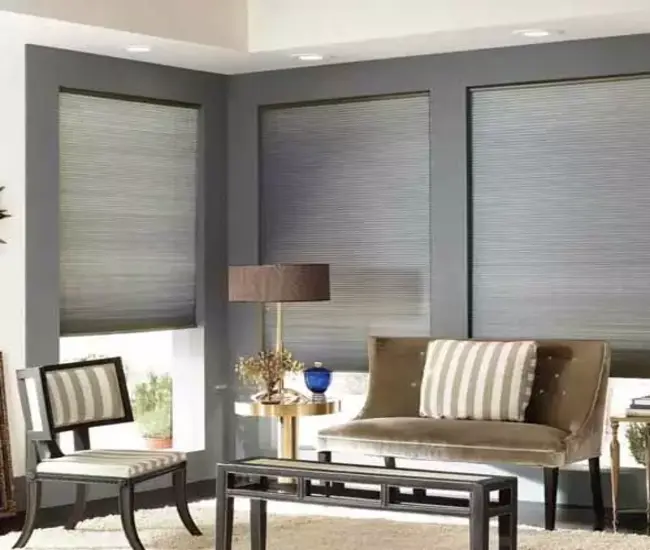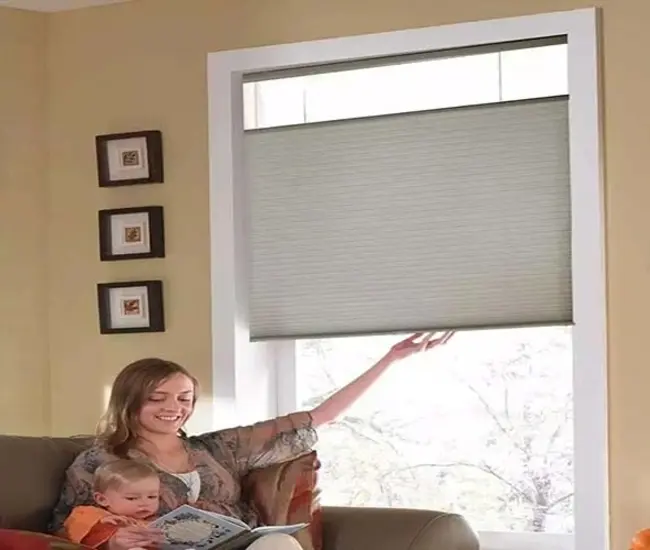Want to insulate your windows with cellular shades but unsure whether to opt for a corded or a cordless design for your energy efficient window coverings? Safety and convenience are the strongest factors to consider when deciding between cordless and corded options. If you want to ensure the safety of your kids & pets, enhance operational convenience, add reachability to hard-to-reach windows, and conform to federal regulations for custom window coverings in the US, we highly recommend cordless cellular shades.
If you don’t live in the US, want to install honeycomb on warehouse windows or any other place where there’re no children aged 1 month to 13 years, your windows are not more than 72” tall, and you also want to save up to $10 per window covering, corded blinds would be a better option. Corded blinds can also be a more practical option for windows ranging in widths from 150 to 200+ inches.
While tightly installed cellular shades can reduce unwanted solar heat gain by 60% in summer and prevent heat loss by 40% in winter, they can pose a strangulation hazard to your little ones and pets.
This post delves deep into the key differences between corded and cordless cellular shades with pros and cons in terms of security and convenience, helping you make an informed decision when shopping for new safe and easy-to-use window treatments.
Corded vs Cordless Cellular Shades – Deep Comparison of Safety & Convenience

Corded Cellular Shades – Pros & Cons
Pros
- Lower cost – you can get a corded cellular shade for $30 to $35 for a 24×36” window, while a cordless option will cost at least $45.
- Enhanced durability – simple, sturdy construction without the intricacy of concealed cords
- Reliable operation and longevity – fewer internal moving parts compared to cordless cellular blinds
- More practical on oversized windows – lift cords are strong enough to raise 120” or wider fabrics without snapping or failing
- Lower maintenance costs due to fewer hardware components
- Consistent performance – uninterrupted operation, day and night
Cons
- Serious (even fatal) strangulation hazard – unsafe, unsecure option for families with young children and pets
- Cluttered look – Visible cords and loops for operation dim the attractiveness of your window covering.
- An inconvenient option due to loose, dangling (and ofttimes tangled) cords
- Less precision and adjustment in positioning – difficulty in achieving the accurate level of brightness and privacy in your home
Cordless Cellular Shades – Pros & Cons
Pros
- Totally Child Safe – Zero chances of strangulation or injury to your little ones, as there’re no hazardous cords attached.
- Easy, One Touch Lift – you can easily raise and adjust your cordless magnetic-pull shades with the touch of your finger!
- Precise, Jerk-free Operation – No cords means no sudden, quick movement of the fabric, allowing you to precisely adjust the height of the blind to the fraction of a centimeter!
- 100% Legal Compliance – If you use cordless cellular shades in your residential or commercial building, you won’t face litigation charges for violating federal child safety regulations for custom window coverings.
- Ultimate Functional Flexibility and Freedom – Available in top down bottom cordless option (such as Top Down Bottom Up Cordless Cellular Shades Exquisite) for more convenience, freedom and flexibility in regulating light, temperature, ventilation, and privacy in your space.
- Cleaner Look – No stray cords give your cordless cellular shades a neat, clutter-free look.
- Adding Value to Your Property – Offering enhanced safety and luxury, cordless cellular shades will increase livability and financial worth of your residential or commercial space.
Cons
- Entail high-cost maintenance and repair costs due to potential issues with the complicated cordless hardware.
- Less consistent performance – if any fragile component of the cordless lift system gets broken due to more frequent use and physical impact (when kids or pets play with your blinds), they may stop operating or get jammed.
- The motorized cordless option is much costlier – compare the $273.46 of Double Cellular Light Filtering Shades Elite with $344.52 of motorized cellular blinds for the same-sized (182.28cm by 182.88cm) window.
- Higher lift failure rates due to issues with their internal spring, tension mechanisms, and motor, battery, or wireless remote (if they are motorized)
- Difficult to operate on very large windows, measuring over 100 by 120 inches in width and tallness, respectively.
- Shorter lifespans compared to corded lift systems.
- Costlier replacement, as cordless shades are typically more expensive.
How to Convert Your Existing Corded Cellular Shades into Cordless?

Option 1: Replace String-Based Control with Bottom Rail Lift System – An Inexpensive, Temporary Solution
- Step 1: Remove your cellular shade from the window.
- Step 2: Remove the end caps from the both ends of the bottom rail and headrail.
- Step 3: Slide the tilt rod out of the tilt mechanism, without removing it completely.
- Step 4: Remove the old corded mechanism from both the rails.
- Step 5: Thread the new bottom rail lift cords and connect them to the top rail, making sure the cords run concealed at the back of the cellular shade.
- Step 6: Cut away any visible strings using a pair of scissors.
- Step 7: Re-mount your cellular shades and test cordless operation. Make adjustments, if needed.
Option 2: Install a Retrofit Motor Kit – An Expensive But Luxurious Option
- Step 1: Unclip your cellular shades and remove the chain drive lift system with a gentle tug.
- Step 2: Grab the motorization kit and slide it into the chain drive end of your honeycomb blinds.
- Step 3: Integrate the wireless remote control into the motor.
- Step 4: Your newly motorized cellular shades are ready to be used.
Option 3: Purchased New Cordless Blinds – One-Time, Permanent Solution
Purchase new cellular shades with built-in cordless control mechanism, such as Cordless Cellular Shades Essential (manual) or Motorized Cellular Shades (automatic with wireless remote control). Standard corded cellular shades are typically priced between $34 and $115 for 18×24” to 72×72” window openings. And motorized options usually range from $170 to $400 for 21×24” to 72×72” window sizes.
How to Integrate Cordless Lift and Tilt Mechanism into Corded Cellular Blinds
- Step 1: Unmount the shades and remove the old corded lift system
- Step 2: Install new cordless lift and tilt hardware into the headrail and bottom rail
- Step 3: Remount your insulating honeycomb shades. They’re ready to use!
FAQs
Is it better to get cordless or corded blinds?
It is not only better but also a legal requirement in the US to get cordless blinds due to child safety concerns. However, cordless blinds become less practical when dealing with extra-wide (more than 100”) or extra large (over 100×120”) windows. But there is a solution in the form of motorization add-on. Motorized or smart cordless blinds with wireless remote control will perform better, safer, and easier.
What are the disadvantages of cordless blinds?
- Relatively higher upfront cost – typically cost $5 to $20 more than a corded blind (and $100 to $200, if you go for motorized cordless cellular shades)
- May involve increased repair costs due to concealed lift mechanism and battery needs
- Limited size capabilities for very wide windows, exceeding 120 inches
Are cellular shades out of style in 2025?
No, cellular shades are still in style in 2025 because:
- Increased need for energy efficiency (for cellular shades provide insulation) as the world’s energy resources face depletion.
- Available in various sizes, styles, and colors, they can complement every window and room decor.
- You can hang cellular shades on every window throughout your home.
- Top-down/bottom-up design and their ability to be paired with an opaque liner and a sheer shade gives cellular shades maximum versatility.
Why did they stop making blinds with cords?
Window treatments manufacturers in the United States stopped making blinds with cords w.e.f. December 15, 2018, in response to fears corded blinds could injure or kill children and pets by strangulation. On January 25, 2018, the Window Covering Manufacturers Association (WCMA) approved a new window covering safety standard by the American National Institute (ANSI), banning window treatments with accessible lift cords or strings.
According to a study published in ‘Pediatrics’ journal in 2017, about 17,000 children under 6 went to the emergency room for injuries related to corded blinds and shades between 1990 and 2015, i.e, almost two kids got injured a day.
According to the United States Consumer Product Safety Commission’s (CPSC) findings, 50 infants and young children died between 2012 and 2017 due to window cord strangulation.
The Commission (CPSC) finalized a rule in 2022, banning the use of accessible cords on window coverings.
Need More Help?
Need design consultation or any other help with choosing between corded or cordless cell shades? We invite you to 24/7 live chat. Or contact us at (800) 863-6109, or customerservice@affordableblinds.com for further assistance.

Leave a Reply